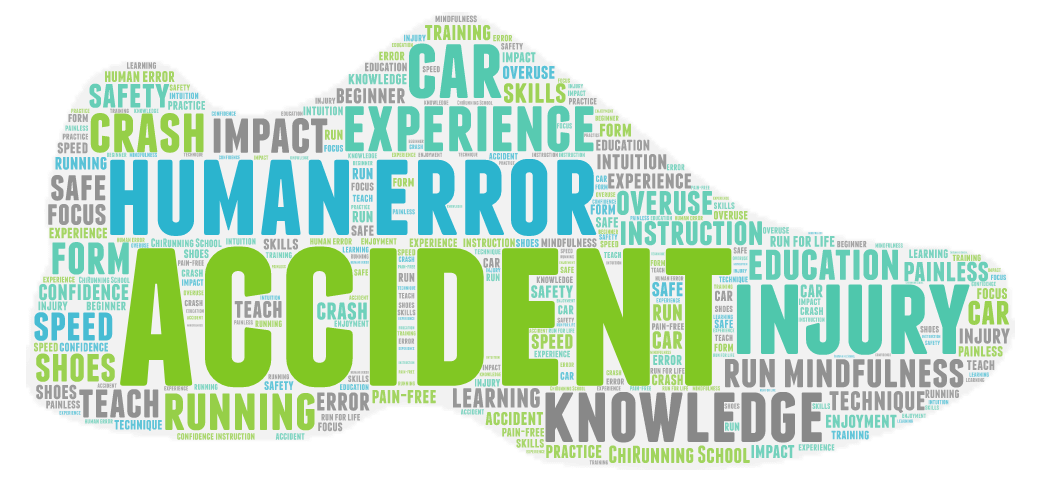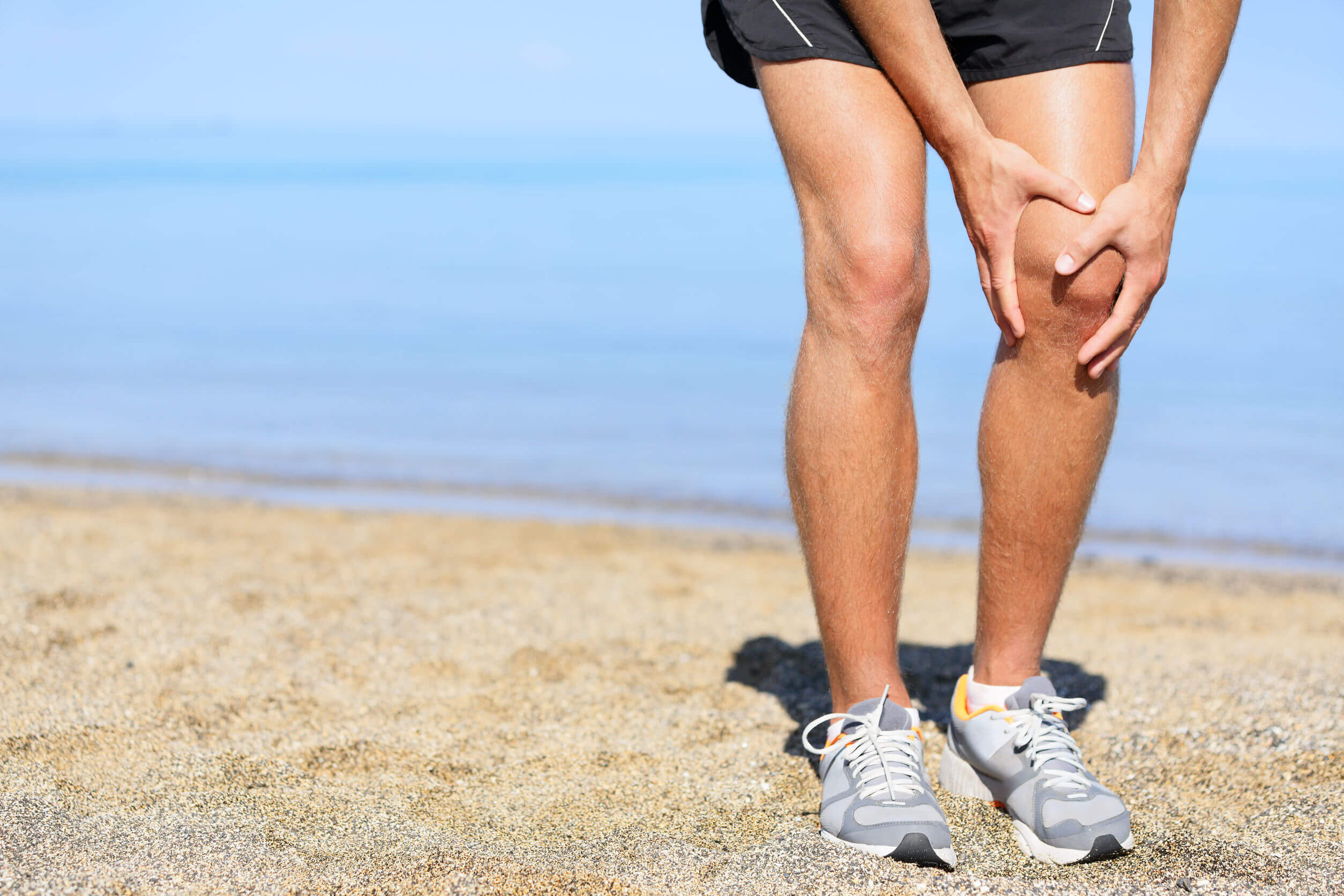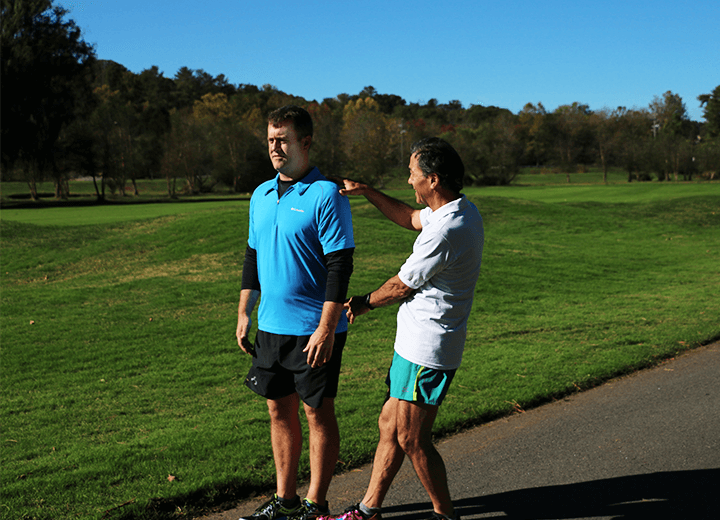Written by: Katherine Dreyer, Co-founder of ChiRunning, ChiWalking & ChiLiving

In 2014 there was a push in the media, and a new requirement in many state laws, that car accidents should no longer be called accidents, but to more accurately be called a crash or collision. The idea was to get people to realize that human error is the main cause of accidents.
According to the New York Times, “Almost all crashes stem from driver behavior, like drinking, distracted driving and other risky activities. About six percent are caused by vehicle malfunctions, weather, and other factors.”
We don’t have exact statistics for running injuries, but we do know that running is a high injury sport and many of those injuries could be avoided with good running technique and appropriate training.
Generally, we put running injuries into two main categories: Impact and overuse injuries. For now, let’s look at three areas to explore the nature of running injuries:
- Running injury from an accident

- Running injury from a lack of knowledge or experience

- Running injury from human error

Running injury from an accident
Life happens– unavoidable accidents are just a part of being human. Just like being in a car accident that is not your fault, there are times you get injured and there’s not a darn thing you can do about it, such as being hit by a bike, vehicle or another runner who has tripped and taken you down too.
Slipping on an unexpected patch of ice or mud could also fall into the accident category. Tripping, rolling your ankle on a curb, getting your shoelaces caught in a tree root on a trail can mostly be in the accident category. But in actuality, there are techniques and a level of conditioning that could mitigate the chances of even that happening. So yes, they are accidents, but in many cases could also fall into the human error category.

I used to think rolling my ankle and tripping were accidents, but I’ve learned that the ChiRunning technique is a strong deterrent to both. Strengthening your core, as you do in ChiRunning, and creating proper balance makes you less likely to roll your ankle because you are more agile and light on your feet. The Chi Focus of lifting your ankle makes you less likely to trip over roots, rocks or uneven terrain. All the technique focuses help you to become more aware of your body, the requirements of the terrain, and the needs of the moment.
Yes, accidents happen, but just like car crashes, there is a lot you can do to be a safe driver and a safe runner.
Quick tip for trail running: Fold the loops of your laces into the web of your laces and you’ll never get yanked by your shoelaces getting caught in a branch again.
Running injury from a lack of knowledge or experience
Teaching my daughter to drive was not an easy experience. Terrifying, actually. Today, (knock on wood) she’s truly a good, and safe driver, at least when I’m with her. I know she’s aware of the dangers and consequences of unsafe driving habits.
I taught her to never tailgate; always be aware of kids, animals, and other cars on the road; maintain a safe speed; and to put on a playlist of music before taking off, so she can focus on the road. I started pointing out unsafe drivers about a year before she got her driver’s permit in addition to difficult or dangerous places that needed special attention in our small but busy city. Of course, she also participated in Driver’s Education, which is required in North Carolina like most other US states.

When it comes to running, most people don’t get the kind of education and support they need. This led us to create the ChiRunning School to educate runners on how to run safely and correctly! Similar to Driver’s Ed, we think proper running education should also be required for new and experienced runners alike! We’ve got the idea that “just doing it” or “give it your best shot” is the best way to run. For a limited few it works, but usually, as those “natural athletes” age, they need more than their natural inclination to keep them going and injury-free. Learning some basic skills builds confidence and dramatically reduces our potential for injury, especially for beginners.
Injuries from lack of education are, I think, the biggest of these 3 categories. Here are some conventional misconceptions about running:
- You can’t learn to run– just run as you did as a kid
- It’s supposed to be a strenuous workout for it to be valuable
- Your legs need to get stronger for you to get faster
- Speed matters
- If you walk-run it should be in specific intervals
- You should be able to run a 5K in 8 weeks, a 10K in 12 weeks, a half marathon in 16 weeks and a marathon in 20 weeks. Some plans are more aggressive than that, even for absolute beginners.
- If you have pain, knee or otherwise, you’re not meant to run
- Or, the worst one of all: running is painful so just run through the pain (“No Pain, All Gain”)
Each one of these beliefs can lead to a host of unnecessary injuries, from either impact or overusing muscles that should hardly be used in the first place. These beliefs can also keep you from enjoying this wonderful sport, thinking your running days are over at the first sign of pain.
The truth is, with some simple adjustments, you could continue running for the rest of your life. Your body is built to run– no matter your age or body type.
Running injuries from human error and making mistakes
This last category is what happens when people know better, but don’t listen to their body, their intuition, or the basis of knowledge they’ve cultivated. These injuries are the crashes and collisions of human error and run the gamut of running injuries: from knee pain to shin splints to plantar fasciitis and IT band syndrome.
Hearing people say they’ve signed up for a half or full marathon but haven’t been training, I get the sense of an impending crash.
Here are several mistakes I see people make causing injury (even when they know better):
- Running too far or too fast for your level of technique and conditioning
- Not listening to the early signs of pain
- Trying to keep up with faster-paced runners
- Starting a run too fast without warming up
- Stretching cold muscles
- Overusing your lower legs, instead of using a gravity-assisted running technique
- Poor diet choices including dehydration, low electrolytes, not enough clean fuel
- Poor-fitting, worn-out or overbuilt shoes
- Not adapting your technique to the terrain
As one of our Master Instructors recently said, “It’s crucial to get your mind’s concept of what you should be able to do, out of your running, and let your body’s needs rule your workouts.”
The bottom line: Running is a high injury sport but you’re far less likely to injure yourself when you get the education and support you deserve while maintaining a mindful approach to your practice.
[thrive_leads id=’5814′]

